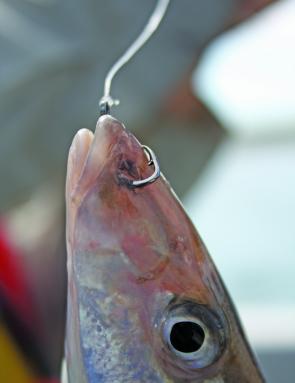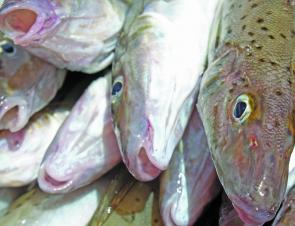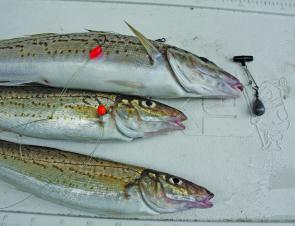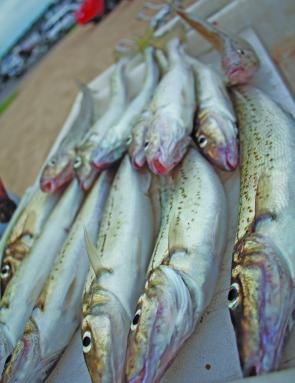My first contact with these marvellous fish was about 27 years ago fishing Port Welshpool with a schoolmate and his dad.
Tucked in behind Snake Island we regularly caught big bags of quality specimens that seemed to be as long as a cricket bat but I’m sure that’s just my memory playing tricks on me – the term kidney slapper comes to mind however. I distinctly remember that we only caught fish when the tide was running and nothing has changed much in that regard.
Since that big introduction to whiting fishing, I have not experienced fish of that size again but have enjoyed catching them none the less at both ends of the state and into South Australia.
With a distribution covering the South Australian border to the west of Victoria, the north and east coasts of Tasmania throughout Victoria and across the NSW border, Victoria is a whiting stronghold right in the middle of their range. Slender, stunningly marked, hard fighting and extremely delicious: I can’t find enough reasons to talk them up! Favouring tidal inshore bays and inlets when juvenile to mid-sized and more so offshore when reaching maturity ‘tingas’ as they are affectionately known are so accessible.
I am far from a whiting expert, those that fish for them almost exclusively deserve that title however I am certain I know enough about them to offer a few tips on locating them and the techniques that work when snapper fever wanes.
Whiting generally favour shallow water where they scour the sea floor for worms, crabs, Bass yabbies and so on. They are never far from reef or sea grass beds with interspersed sand patches. The only thing that seems to change is that when they get truly big they seem to be more a deeper water option; often the better fish of 45cm or so occur offshore. These are often snagged as a by-catch when chasing snapper.
Without any doubt most whiting fishing in Victoria occurs in bays and inlets for a variety of access reasons and the fishing in these locations is predictably very good. There are plenty of offshore exceptions however, and Portland, without an estuary or large bay, sees anglers push small craft into inshore waters like the points to the west and the east around the less heavy areas of Minerva Reef.
From Portland through Apollo Bay and right through to Point Lonsdale excellent whiting ground abound and are only limited by safe launching options and the swell and ocean conditions. Once you arrive at Port Phillip, almost the entire shallow margin to around 8m produce whiting and some of the better grounds exist off Swan Bay, Sorrento, Werribee and Brighton.
Further across to Western Port, the deeper waters off Cat Bay and Balnarring are famous for big fish
Western Port’s banks and tidal-scoured channel edges are worth a look and represent the best water close to Melbourne especially since the closure to commercial netting. To the east Andersons Inlet at Inverloch can produce some nice fish but personally I struggle a bit here to find legal sizes ones but I think that’s just me.
Further east again some supreme water is found that seems to survive well with the lack of Melbourne pressure (except for the commercial netting). Starting with Walkerville/Waratah Bay where beach-launched smaller boats have access to some great whiting territory, the awesome waters either side of Wilsons Promontory offer up the whiting hot spots of Shallow Inlet, Corner Inlet and my sentimental favourite Port Welshpool.
Further into Gippsland there are numerous excellent areas for whiting both inshore and in a variety of entrances such as Port Albert and McLoughlins Beach and beyond to the border, but as you get closer they seem to thin out. Wherever you are hunting them, we are home to some great opportunities and if venture outside, lightly fished patches where some bigger fish truly abound if you can find a patch.
Whilst whiting put up a great fight on light tackle, the biggest consideration comes with the ability to detect a small ‘tap-tap’ take. This is where the nibble tip rods come to the fore. In deeper more tidal areas a little more backbone is required from the rod, more to deal with the sinker required.
Some rod length is an asset and 7’6” rods are about ideal to be able to clear past outboard motors with enough guts to simply lift the fish in the boat. Although tackle purists may consider this sacrilege, I find that modern Egi rods fit the bill almost perfectly for whiting.
Small 2500 sized reels are a great match to this type of outfit and with some 3-4kg braid you have the ultimate combination of thin diameter to keep a tight line in a strong tide and zero stretch for good bite detection. Mono will certainly do but the gel spun lines are simply superior.
I like to employ a running sinker rig and personally thread on an Ezi-rig with a small bomb sinker to suit the tide and attach a small black swivel between the gel spun and the 7kg mono leader and I employ a two dropper rig with red bead or tube as a bite attractor; feathered jigs have become popular as well.
As far as hooks there are three main ways to go – long shanks, shiners or circles. They all work and for my money a shiner gives some advantages in that the soft baits sit well in the larger gape, expose plenty of point and provide a good balance between an ability to strike when the fish are mucking around and solid hook ups in the rod holder when the fish are being aggressive.
Whiting are usually hooked in the mouth, aiding a release when small fish are about. Sizes six to two at the larger end are ideal depending upon which hook style you choose as they vary.
As much as I love tackle innovations and lure fishing, whiting are a very marginal luring target. While certainly not an impossible option, they seem to lack the predatory drive in Victorian waters.
King George will on occasion take a scented-style soft plastic but it’s not a super common event, without doubt baits are the go: I hope you prove me wrong and often.
The best spots for whiting I find are the sand patches adjacent weed or reef on the edge of the strong tidal flow. The well drilled practice of moving every 20 minutes or so if no fish are encountered is a good one: yesterday’s hot spot can be today’s desolate patch of sea with these mobile critters, but they may not be far away.
Look for the sand and reef/weed patches in 3-8m of water or even deeper offshore and anchor up without making too much noise as they can be flighty critters. Whilst not an absolute, I believe that turning off your sounder once at anchor is a top idea.
Using berley to bring in whiting is a catch 22. It most certainly will work but with it will often be a variety of undesirables such as tiny flathead, toadfish and bigger pests. I much more prefer to add berley into the mix when the fish are there and biting and this can often have the effect of firing the fish up and keeping them right where you want them – there is nothing like a bag out session on a single anchor drop!
Berley can comprise some crushed up pipi or mussel shells, any fine mixture in a berley cage deployed to the floor or a fast sink commercial mix such as Zealcol Whiting Snack. Concentrate your efforts during the middle of the tides as the slack water period is often devoid of quality fish.
Whiting predominantly feed on the ocean floor, and so the perfect baits are sand worms, pipis, mussels and Bass yabbies as is a small section of tenderised squid flap or tentacle so that its sticky and oozing out scent.
Many claims are made about the attributes of our various species but one I stand by are the eating qualities of king George whiting. Filleted, boned and shallow pan fried in some vegetable oil with a light dusting of flour is terrific.
Some chips and salad combined with a beer or two is a great way to cap off a good summer day on the water.
And don’t forget your bag limits.
Reads: 14173
Whiting make a great kid target - Noah Tucker has been refining his skills on them for years!

Circle hooks are a great option when the bite is hot as de-hooking getting a bait back in the water is usually a cinch!

A bag of quality fish destined for the filleting station!

A simple running sinker, two-hook rig does the job in a variety of conditions.

These exposed mudflats covered in weed give a good idea of where the fish will be as the tide fills - prime territory!

Dan Lee of Peninsula Total Tackle displays a Point Nepean thumper.

A whole pile of very tasty fish – one of Victoria’s best species for sport and the table.

A small amount of berley can keep the fish biting and in your area - use sparingly!




